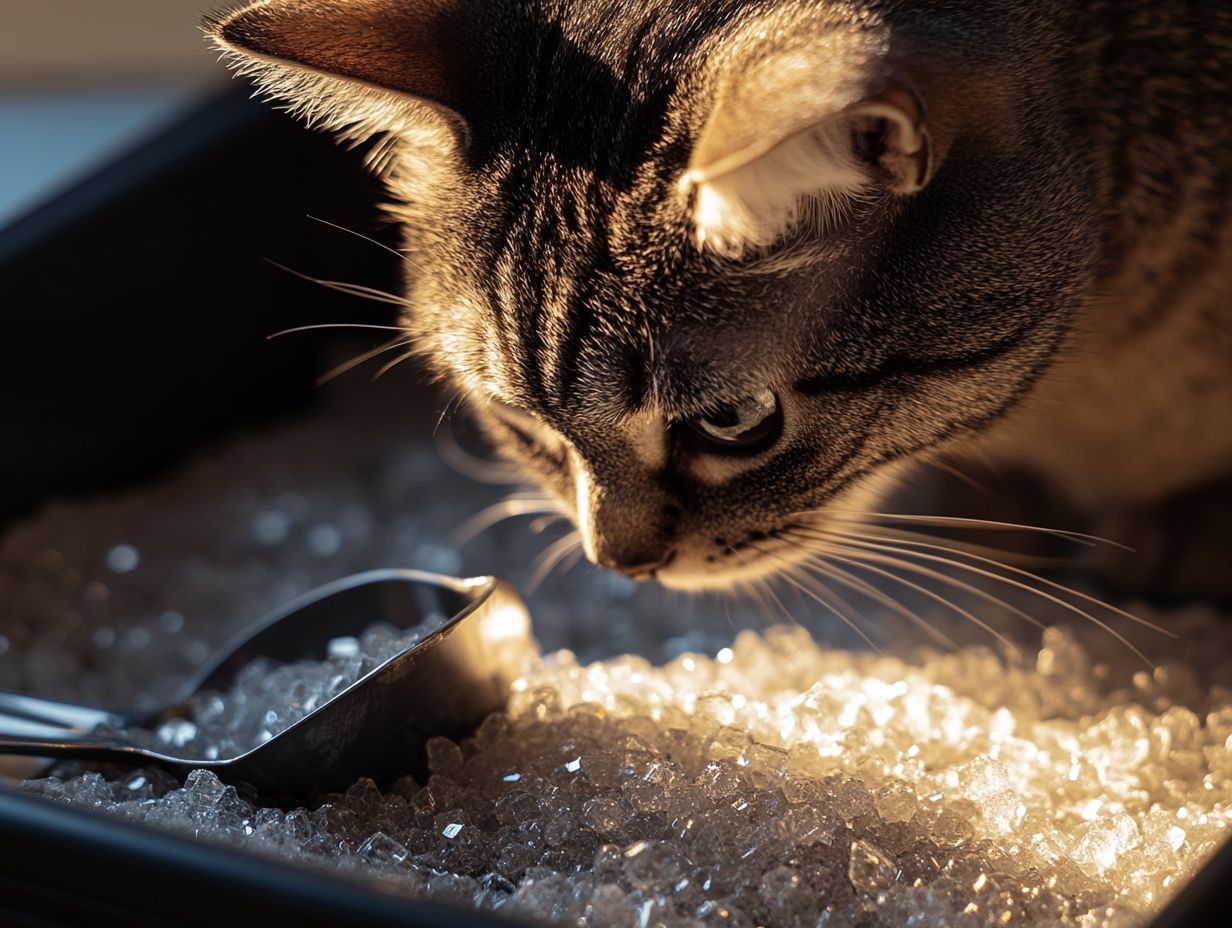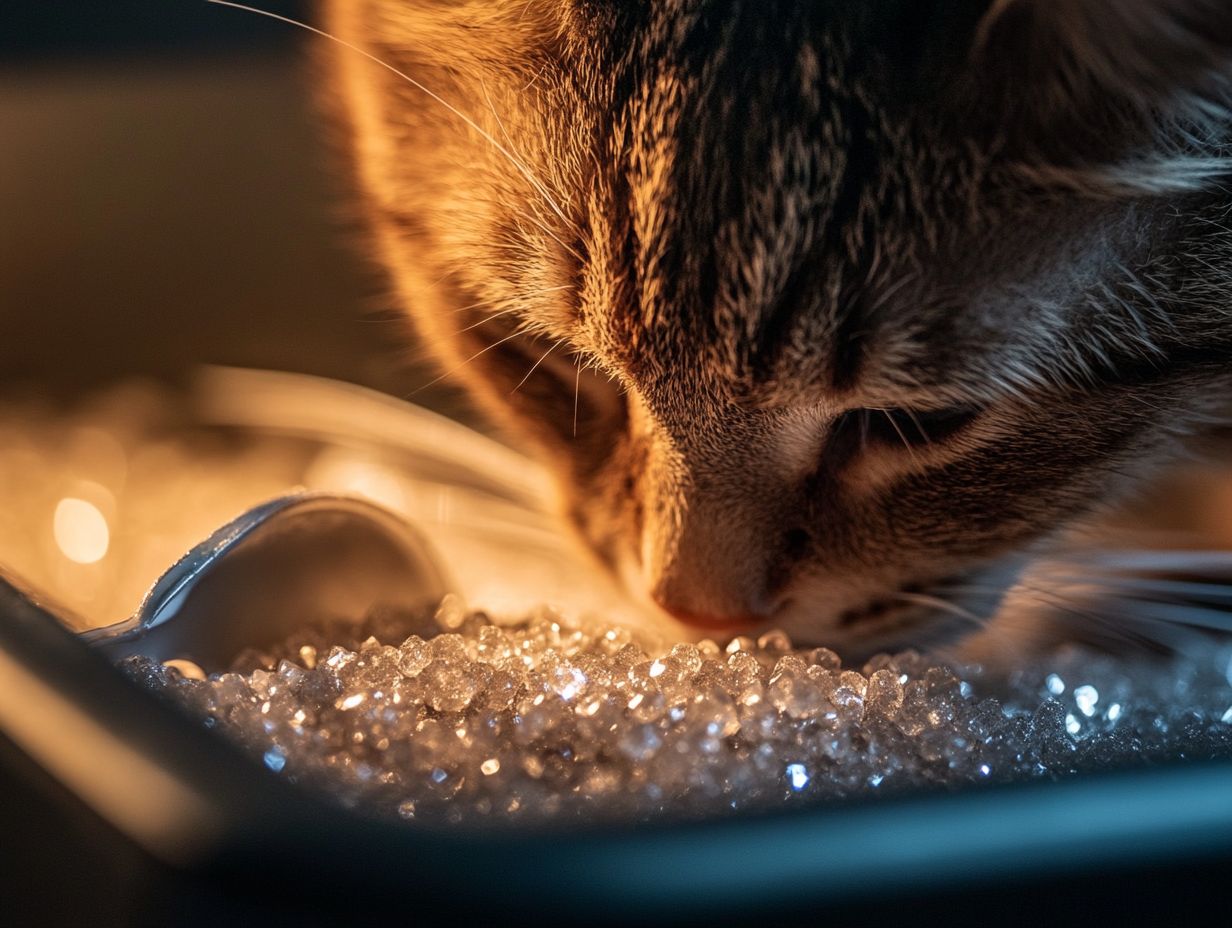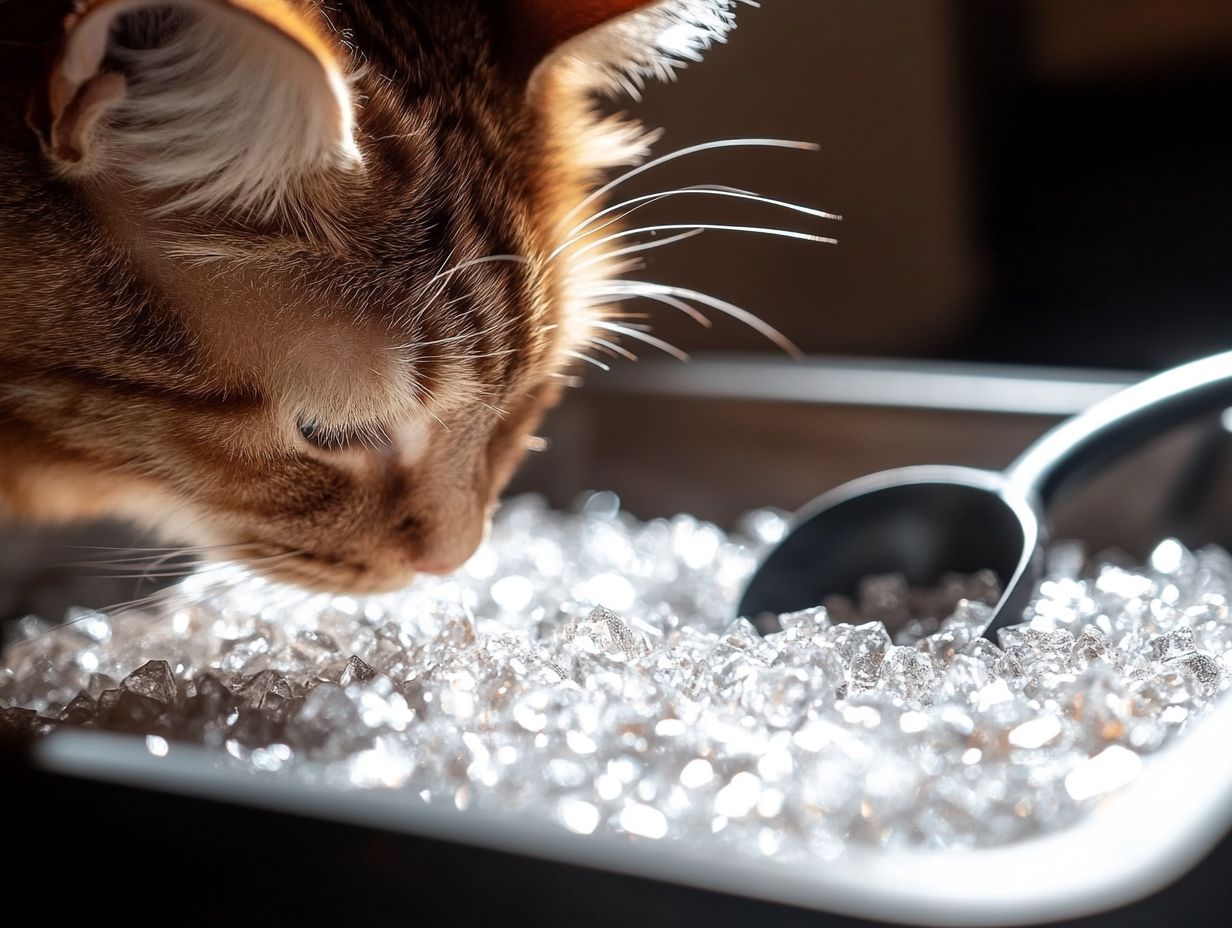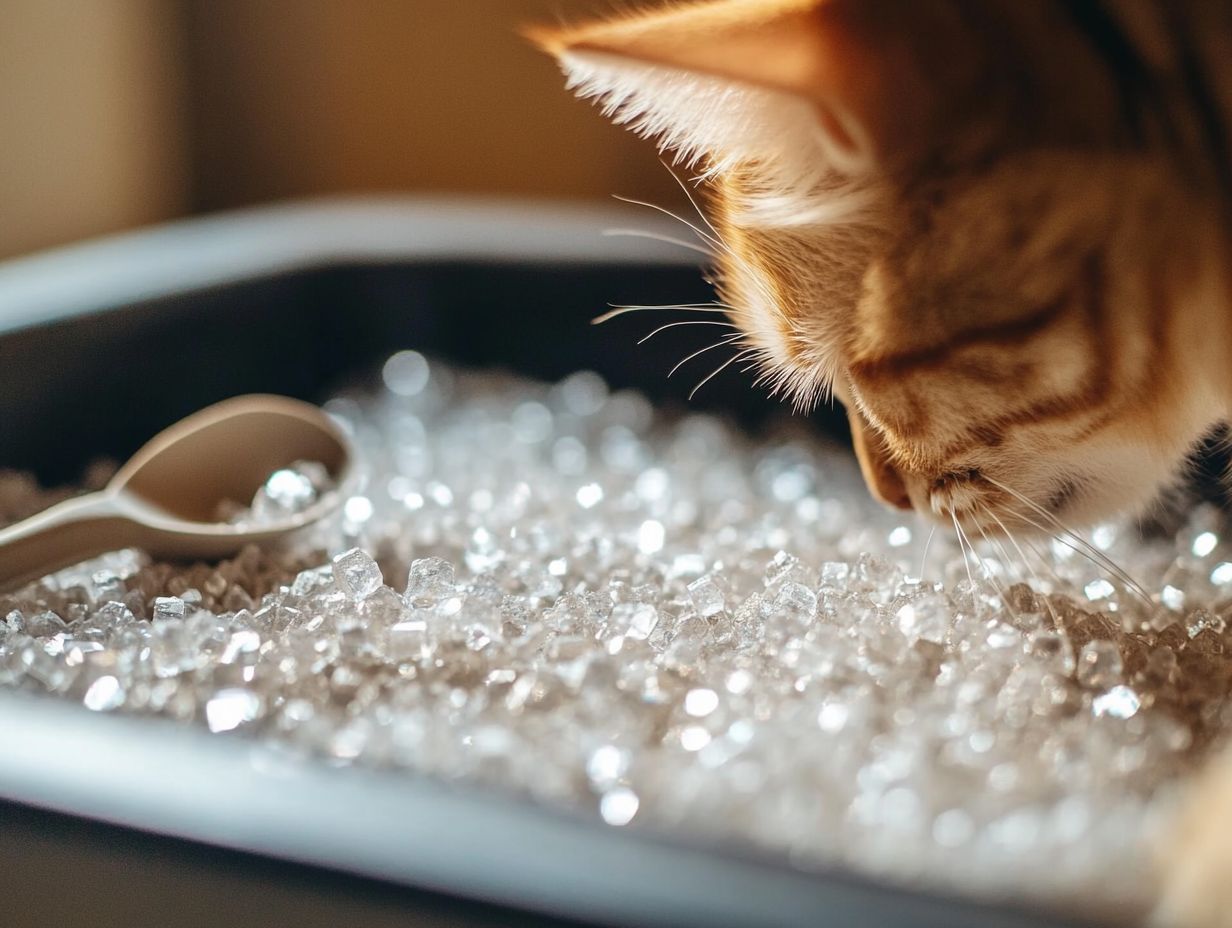Choosing the right litter for your feline friend can be a daunting task, especially with so many cat litter options available.
Crystal cat litter has gained popularity for its unique properties and benefits, but it also comes with a few drawbacks.
This article explores what crystal cat litter is, examines its superior absorbency, odor control, and highlights the benefits of using highly absorbent, non-clumping litter made from crystal silica.
It also highlights potential concerns, offers guidance on usage, and suggests some alternative eco-friendly litter types like wheat litter, pine litter, and corn litter to help you make an informed decision for your kitty.
Key Takeaways:

- Crystal cat litter offers superior absorbency, reduced odor, and longer lasting performance compared to other types of litter.
- However, it can be expensive, not environmentally friendly compared to biodegradable options, and hazardous if ingested.
- Proper use and maintenance of crystal cat litter, such as scooping daily and replacing every 2-3 weeks, can help ensure its effectiveness and ease of cleaning.
Understanding Crystal Cat Litter: What Is It?
Crystal cat litter is a modern type of cat litter primarily made from silica gel beads, a sand-like material derived from quartz sand. This litter is popular among cat owners looking for lightweight litter options that effectively controls odors.
The absorbent material is dust-free, which helps minimize the risk of breathing issues for both cats and their owners. Additionally, crystal cat litter boasts a long shelf life and is easy to clean.
What Are the Benefits of Crystal Cat Litter?
Crystal cat litter offers several advantages, including superior odor control due to the moisture-absorbing properties of silica gel, which helps maintain a fresher litter box.
Its high absorbency allows crystal cat litter to last longer than traditional clay litter, making litter maintenance and litter box cleaning simpler.
1. Superior Absorbency
One of the most significant benefits of crystal cat litter is its superior absorbency compared to traditional clay litter. The absorbent material in crystal cat litter quickly absorbs moisture, preventing the formation of clumps. This enhanced absorbency also helps reduce tracking, a common issue faced by many cat owners.
Additionally, crystal litter is lighter and produces less dust than clay varieties, fostering a healthier environment for both cats and their owners. The reduced dust levels mean fewer respiratory irritants, making it a better choice for individuals with allergies or asthma.
Furthermore, the advanced materials used in crystal litter effectively neutralize odors, which not only decreases the frequency of litter box maintenance but also enhances the comfort and well-being of the cats.
2. Reduced Odor
Crystal cat litter offers superior odor management by effectively managing odors and neutralizing unpleasant smells that may arise in the litter box. Thanks to the moisture-absorbing properties of silica gel, cat owners can enjoy a cleaner living environment with minimal litter box odor.
Unlike traditional clay litter, which tends to clump and retain moisture—leading to odor buildup—crystal cat litter rapidly absorbs liquids and traps odors, keeping the litter box fresher for a longer period. This innovative solution not only simplifies maintenance but also contributes to a healthier atmosphere for both pets and their owners.
The differences in performance highlight the significance of odor control in pet care, as a clean-smelling home can reduce stress levels for both cats and their humans, fostering a more harmonious living arrangement.
3. Longer Lasting
One of the significant advantages of crystal cat litter is its long-lasting nature, which translates into substantial savings for cat owners. The durable materials used in crystal cat litter ensure it remains effective for an extended period, resulting in less frequent changes and easier litter box maintenance.
This enhanced longevity leads to fewer purchases over time, making it a cost-effective option. Additionally, it aligns with eco-friendly options that many conscientious pet owners seek.
Transitioning Your Cat to Crystal Litter
Transitioning your cat to crystal litter can be a gradual process. Start by mixing a small amount of crystal litter with your cat’s current litter, gradually increasing the ratio over several days. This helps your cat acclimate to the new texture and scent, minimizing resistance.
Exploring Eco-Friendly Alternatives
While crystal cat litter is effective, many pet owners may prefer eco-friendly options. Here are some alternatives:
- Wheat Litter: Made from processed wheat, it clumps well and is biodegradable. However, it may attract pests if not stored properly.
- Pine Litter: Made from reclaimed wood, it’s absorbent and has a natural pine scent. But it can be less effective at odor control compared to crystal litter.
- Corn Litter: Biodegradable and clumping, corn litter is safe and effective, but it can be more expensive than traditional options.
Recommended Brands
When selecting crystal cat litter, consider popular brands like PetSafe, Tidy Cats, and PetFusion. These brands are known for their efficacy and safety.
Conclusion
In summary, crystal cat litter offers several benefits, including superior absorbency and odor control, making it a popular choice among cat owners. However, it’s important to consider potential drawbacks, such as cost and environmental impact. Consider trying crystal cat litter to see if it suits both you and your cat.
By opting for crystal cat litter, individuals can reduce their carbon footprint by contributing less waste to landfills compared to traditional litter types. According to a study by the Environmental Science Journal, pet owners using crystal litter can reduce landfill waste by up to 50%. Moreover, an increasing number of eco-friendly brands like Snappy Tom and Pidan are producing crystal litters from sustainable materials, such as recycled glass or natural minerals, further appealing to those who wish to balance pet ownership with environmental stewardship.
4. Low Dust
One of the most significant benefits of crystal cat litter is its low dust content, making it safer and healthier for both cats and humans. A study from the Allergy Research Group found that nearly dust-free litter helps reduce respiratory issues commonly associated with traditional cat litter products that produce silica dust. This aspect is particularly crucial for individuals with allergies or asthma, as traditional cat litter can exacerbate these conditions, potentially leading to discomfort or even medical emergencies. Crystal cat litter contributes to a cleaner indoor environment by lowering the levels of allergens and irritants in the air.
For cat owners concerned about both their pets’ health and their own, opting for low-dust cat litter is an effective way to create a safer and cleaner home. Additionally, the tiny, absorbent crystals effectively trap odors without releasing harmful particles into the air, allowing cat owners to feel more at ease knowing their pets have a clean space to relieve themselves, enhancing overall litter box hygiene.
What Are the Drawbacks of Crystal Cat Litter?

Crystal cat litter offers several advantages, but pet owners should also be aware of its drawbacks. One significant disadvantage is the cost, as crystal cat litter tends to be more expensive than traditional clay litter options. A comparison shows that while a 20-pound bag of clay litter may cost around $10, a similar size of crystal litter can range from $15 to $25. Additionally, some owners have noted that their pets are less inclined to use crystal litter due to its texture. This reluctance can complicate cleaning and potentially pose health risks like allergies associated with improper use of the litter box.
1. Can Be Expensive
One of the main disadvantages of crystal cat litter is its potentially high cost compared to traditional clay litter products. This increased price may discourage some cat owners from choosing crystal litter as their primary option, especially if they are on a tight budget and considering cheaper litter alternatives. The higher cost of crystal cat litter can be attributed to several factors, including the complex manufacturing process and the use of specially engineered materials designed for maximum absorption and odor control. Unlike traditional clay options, which are often sourced from natural deposits and produced in bulk, crystal litter is typically made from synthetic materials, such as silica gel, that undergo extensive processing to enhance their performance. This makes crystal litter a choice for those prioritizing advanced pet care.
This level of production not only raises manufacturing costs but also influences consumer perceptions of its value. Consequently, the higher prices may lead some cat owners to prioritize lower costs over quality, potentially overlooking the benefits that crystal litter offers, such as longer lifespan and fewer litter changes.
2. Not Environmentally Friendly
Cat owners should also consider that crystal cat litter is not as environmentally friendly as other alternatives available on the market. Unlike biodegradable options such as wheat, corn litter, or paper litter, which break down naturally and reduce landfill waste, crystal cat litter does not break down easily, raising health concerns about its waste disposal. As a result, when disposed of, it contributes to landfill waste, posing a significant environmental challenge.
3. Can Be Hazardous if Ingested
One significant disadvantage of crystal cat litter is that it can be harmful to cats if ingested. Although the base silica gel material is not toxic, consuming it in large amounts can lead to health issues such as gastrointestinal upset or respiratory complications, highlighting the importance of monitoring cat grooming behaviors closely. To prevent ingestion, pet owners should keep the litter box clean and provide alternative safe materials, such as shredded paper or grass-based litters, to reduce a cat’s interest in the litter.
Key Takeaway: Transitioning your cat to crystal litter can be managed by gradually mixing it with their preferred litter to ease the adjustment. Monitor their behavior to ensure comfort and safety.
Educating yourself about the various types of litter available can help you choose a safe and effective litter product. In this article, you’ll learn how to choose the best cat litter and maintain a clean litter box, creating a safer environment that significantly decreases the risk of accidental ingestion.
How to Use Crystal Cat Litter
To use crystal cat litter effectively, it is essential to maintain a clean litter box free of odors and ensure a consistent cleaning routine.
Instructions for crystal cat litter recommend that cat owners pour 2 to 3 inches (5 to 8 centimeters) of crystals into a clean litter box. This depth is recommended for optimal litter box performance, ensuring adequate odor absorption and liquid drainage. In the context of cat litter, “absorbency” refers to the litter’s ability to soak up moisture and odors.
Additionally, using the right amount simplifies litter maintenance and cleaning routines, enhancing overall litter box hygiene.
1. Fill Litter Box with 2-3 inches of Crystal Cat Litter
The first step in using crystal cat litter is to fill the litter box with an appropriate amount of 2 to 3 inches of the material. This depth is crucial because it allows the absorbent material to effectively manage moisture and odors, enhancing cat litter benefits and creating a better experience for both the cat and its owner.
In contrast to traditional clay or clumping litters, which need to be replaced more frequently and generate more waste due to their poorer moisture retention, the correct depth of crystal litter enhances not only the product’s effectiveness but also its ease of cleaning. For more information on this type of litter, check out the article on Crystal Cat Litter: Benefits and Drawbacks You Should Know.
With crystal litter, liquids are quickly absorbed, and odors are suppressed more effectively for an extended period. Pet owners find that maintaining this depth results in less waste and a cleaner environment.
The balance between effective odor control and ease of maintenance is what makes crystal litter a popular choice among pet owners, underscoring the importance of filling the litter box correctly for optimal use.
Daily Maintenance Tips
2. Scoop Solid Waste Daily
Cat owners should scoop solid waste from the litter box daily to maintain cleanliness. Regular cleaning prevents the accumulation of odors and ensures effective odor control through the absorbent properties of crystal cat litter.
The litter should be completely changed every two to three weeks, depending on the number of cats in the household and the cat’s health, as advised by veterinarians. This practice not only enhances the litter’s absorbency but also helps keep the area around the litter box clean.
Wet spots and clumps should be promptly cleaned to prevent the spread of bacteria that can pose health risks to both cats and humans. By adhering to a regular cleaning schedule and monitoring the condition of the litter, cat owners can significantly improve their pets’ comfort and health while contributing to a cleaner environment for themselves.
3. Stir Litter Daily to Prevent Clumping

Daily stirring of crystal cat litter is essential to prevent clumping and ensure even distribution throughout the litter box. This practice maximizes the litter’s absorbency by breaking up any clumps that form and allows for better airflow, enhancing overall cleanliness and odor control.
Frequent mixing helps counteract moisture buildup from the pet’s waste, allowing the crystals to effectively absorb odors and liquids. As a result, the environment remains fresher and healthier for the pet, making the area more inviting.
Regular agitation of the litter ensures that the crystals function optimally, quickly neutralizing any unpleasant odors and creating a more pleasant experience for both the pet and the owner. A well-maintained litter box also reduces the likelihood of the pet developing a reluctance to use it, a common issue with poorly maintained litter conditions.
4. Replace Litter Every 2-3 Weeks
Crystal cat litter should be replaced every 2 to 3 weeks at a minimum to ensure its continued effectiveness. Adhering to this replacement schedule helps keep the litter box clean and odor-free, providing optimal comfort for both the cat and its owner.
Regularly replacing cat litter is essential for maintaining a healthy environment in the home. Over time, cat litter accumulates moisture and odors; if not replaced promptly, unpleasant smells can permeate throughout the house. Consistent litter replacement aids in odor control and ensures the cleanliness of the litter box.
Establish a routine to keep your litter box clean, reducing stress for both you and your cat.
Finding the right cat litter not only keeps your home clean but also encourages your cat to use the litter box consistently. A general rule of thumb is to have one litter box per cat plus one extra to ensure that your feline friends feel comfortable. A clean litter box significantly reduces the likelihood of behavioral issues and enhances the quality of life for pets.
What Are Some Alternatives to Crystal Cat Litter?
Crystal cat litter is a popular type, but various alternatives cater to different preferences. For cat owners seeking an eco-friendly option, biodegradable litter made from materials such as wheat, pine, corn, or recycled paper may be ideal.
Each type of alternative litter presents its own advantages and disadvantages. Below is a comparison chart that highlights key points:
| Type of Litter | Pros | Cons |
|---|---|---|
| Clay Cat Litter | Affordable, effective odor control, clumping | Contributes to landfill waste |
| Pine Cat Litter | Biodegradable, pleasant aroma, softer texture | Some cats may dislike texture, potential dust |
| Corn Cat Litter | Biodegradable, excellent clumping, pleasant scent | Less effective for strong odors, often more expensive |
| Paper Cat Litter | Low tracking, lightweight, non-toxic | Mediocre odor control, requires frequent changes |
| Wheat Cat Litter | Effective clumping, good odor control | May cause sensitivity in some cats |
1. Clay Cat Litter
Clay cat litter has been a popular choice among cat owners for its affordability and effective odor control. While it offers several advantages, it also contributes to landfill accumulation due to its scoopable nature.
Crystal cat litter, made from silica gel, tends to remain fresh for a longer period and absorbs moisture effectively, reducing the frequency of litter changes. Its disadvantages include a higher initial cost, and studies indicate that some cats may show aversion to its texture.
2. Pine Cat Litter
Pine cat litter is a biodegradable alternative made from reclaimed wood, featuring natural odor control properties. It is becoming more popular among cat owners who prefer sustainable litter solutions.
Although pine litter offers a pleasant wood aroma, it may not be suitable for all cats due to its texture and potential dust.
3. Corn Cat Litter
Corn cat litter is a biodegradable product made from natural corn kernels that provides excellent clumping ability and a pleasant scent, contributing to effective litter box hygiene.
While many appreciate its absorbent properties, some consumers have found it less effective at managing strong odors and note that it is often more expensive than other options.
4. Paper Cat Litter
Pros:
- Low risk of litter tracking
- Lightweight
- Supports a green environment
- Highly absorbent
- Non-toxic for cats and humans
- Non-invasive, making it suitable for shy pets
- Medium cost
Cons:
- Some cats may dislike the texture
- Requires more frequent changes
- Mediocre odor control
- Weak odor absorption
- Can be noisy when used
5. Wheat Cat Litter

Wheat cat litter is a biodegradable option that offers effective clumping action and odor control. It simplifies waste removal by forming solid clumps that are easy to scoop out.
However, some cats may be sensitive to plant-based materials, potentially leading to aversions or health issues.
Addressing Common Problems
If your cat is peeing outside the litter box or exhibiting litter box aversion, it’s essential to examine factors such as the type of litter being used, the cleanliness of the box, and the box’s location. Consulting a veterinarian or an animal behaviorist can provide tailored solutions to these issues.
In conclusion, choosing the right cat litter is crucial to maintaining a harmonious household. Consider your cat’s individual needs, and make an informed decision to ensure their comfort and well-being.
Frequently Asked Questions
What is crystal cat litter and what are its benefits?
Crystal cat litter is a type of cat litter made from silica gel granules. Silica gel is a non-toxic substance used in various moisture-absorbing products. Its benefits include excellent odor control, low dust, and longer-lasting compared to traditional clay litter [source].
Is crystal cat litter safe for my cat?
Yes, crystal cat litter is generally considered safe for cats. However, you should always monitor your cat’s use of the litter and if you notice any adverse reactions, consult with your veterinarian. It’s also advisable to monitor litter box habits to identify any potential health issues, such as urinary tract infections, which might require veterinary attention [source].
How often should I change the crystal cat litter?
Crystal cat litter can last up to a month before needing to be changed, depending on how many cats are using it and how often you scoop it. It is recommended to completely change the litter every 3-4 weeks. For optimal hygiene and odor control, the litter should be scooped daily, regardless of the type used [source].
Are there any drawbacks to using crystal cat litter?
One potential drawback is the higher cost compared to traditional clay litter; additionally, some cats may find the texture uncomfortable, preferring softer alternatives [source].
Can I flush crystal cat litter down the toilet?
No, it is not recommended to flush crystal cat litter down the toilet. The silica gel granules can expand in water and clog pipes. It is best to dispose of used litter in a trash bag [source].
Can I mix crystal cat litter with other types of litter?
It is not recommended to mix crystal cat litter with other types of litter. This can affect its absorption abilities and may cause tracking or clumping issues. Stick to using just one type of litter at a time [source].
How can I transition my cat to crystal cat litter?
To ease the transition to crystal cat litter, consider gradually mixing it with your cat’s preferred litter. This can help your cat adjust to the new texture and scent without causing stress [source].
Conclusion
In summary, crystal cat litter offers several benefits such as excellent odor control and reduced dust, while generally being safe for cats. Regular scooping and monitoring of your cat’s behavior are essential for maintaining hygiene and identifying any health issues. While there are some drawbacks like higher costs and texture preferences, proper transitioning techniques can help adjust your cat to this type of litter effectively.